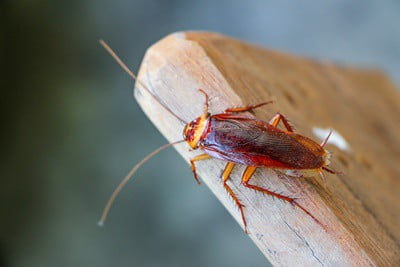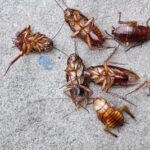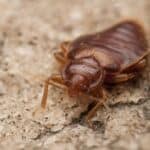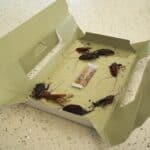Cockroaches are invasive pests, able to spread bacteria and illness throughout your home. They contaminate your living space, eat your food, and may even scurry across you during the night. If you’re battling an infestation, you may wonder why cockroaches even exist. They appear to serve no real purpose.
Cockroaches recycle decay and waste while promoting the nitrogen cycle. They’re a food source for predators and assist the ecosystem in inhospitable places. For humans, they’re a useful ingredient in medicine and invaluable for research. Cockroaches have advanced robotics, prosthetics and are a source of cuisine around the world. Some people even keep Madagaskar hissing cockroaches as domestic pets.
The average house cockroach is a disease-riddled pest that’s worthy of extermination. However, as a creature with more than 4,000 species, only 4 kinds are a nuisance to humans. Most avoid human populations. You can kill off the home invaders guilt-free, but cockroaches have been helping the planet and humans for their entire existence.
Do Cockroaches Serve A Purpose?
Cockroaches are often viewed as meaningless pests. While that’s true inside a person’s home, that doesn’t mean roaches exist for no reason. In nature, they offer many benefits to balance out the ecosystem.
Roaches only become problematic in urban landscapes. Here, they’re separated from their area of expertise, nature. They will adapt to the concrete jungle and seek out food, shelter, and water to survive. Unfortunately, these are found in areas dominated by people. Cockroaches are dangerous to people, not as predators but as contaminates.
- Cockroaches serve as carriers for a range of diseases, viruses, and bacteria.
- They spend their days scurrying around kitchens and bathrooms unwanted. They’ll contaminate food and infect household surfaces with harmful pathogens.
- Their droppings can trigger asthma and allergies or irritate people with a vulnerability to these conditions.
- Roaches are a leading cause of respiratory issues in children.
There’s no good reason to allow an infestation in your home. However, cockroaches fulfill many useful roles on earth. In doing so, they benefit humans outside of our homes.
Why Are Cockroaches Good For The Environment?
So, how do cockroaches excel in nature? Why should we appreciate the roles they fill? Despite being so small, roaches have a considerable impact on our planet. Let’s explore how they contribute to our livelihood each day:
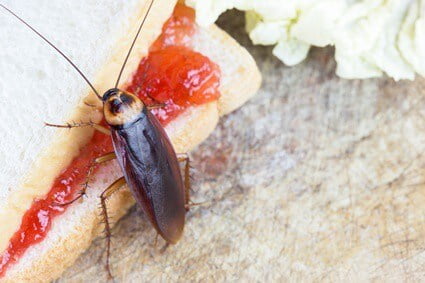
Decomposers
Cockroaches are best known as resilient eaters. From kitchen food to organic waste like hair and skin cells, a roach is happy to eat anything. However, this wasn’t developed just to annoy humans. In nature, roaches will spend their days eating all kinds of decaying matter, including:
- Animal carcasses
- Fallen leaves
- Rotting wood
- Feces and other waste
Insects and certain animals also fulfill this role. However, the endurance of cockroaches and their prolific numbers mean they’re a heavy-hitting contributor. You’ll find them in wooded areas most of all, where organic waste is quick to stack up. Without cockroaches, this waste would be left to rot unattended.
Not only will this build up at an impressive rate, but it will also result in different chemical reactions. In small amounts, general decay is helpful to the environment. In unchecked amounts, that can disrupt the delicate balance of our ecosystem. That’s why decomposers exist; they recycle the decay in other helpful ways.
Nitrogen Cycle
Most of all, cockroaches help contribute to the nitrogen cycle. Nitrogen is a building block of life and crucial in growing plants. Without plants, there would be no food for people or animals.
Nitrogen is most present in the air. It’s then absorbed in the soil, transferred to plants, and eaten by animals. Decomposers, like roaches, eat organic waste and process it through their body. This breaks down the components and releases nitrogen into the soil and air again. Here, it can be reabsorbed by plants. The cycle continues.
Because of this, roaches are very important in the health and livelihood of our plant. If they weren’t around to contribute to the nitrogen cycle, the planet wouldn’t die. However, it would suffer from a massive gap in its ecosystem and its overall productivity.
That sounds like a great responsibility for a small bug. However, you must consider the prolific number of cockroaches and their endurance. Despite only living for 6 months at a time, females can reproduce at an exceptional rate.
As stated, there are over 4,000 species of cockroaches on this planet. The living numbers are countless. Imagine the unbalance that our ecosystem would experience if that many nitrogen-helpers just went away?
Part of The Food Chain
Roaches may seem indestructible, but many creatures rely on them as a food source. Among their predators are:
- Birds
- Rats
- Mice
These animals have other sources of food in their diet. However, roaches offer protein, fiber, and other valuable nutrients. With their prolific numbers, cockroaches also provide a constant, safe food source.
The disappearance of roaches would mean a decline in birds, rats, and mice. With those animals gone, the next predators in line would go hungry. For example, without rats, many reptiles, felines, and birds of prey would suffer.
Furthermore, some insects rely on cockroaches exclusively for their survival. Among these are the parasitic wasps, which specialize in feeding off cockroach eggs. With this express purpose, the anatomy, behaviors, and instincts of the wasp all serve to parasitize cockroaches. The disappearances of roaches would cause this wasp to go extinct. This would result in another ripple in the ecosystem, all the way up the line, perhaps even to humans.
Thrive In Areas Where Other Animals Can’t
As mentioned, other insects and animals can serve as decomposers. Other species also supplement a cockroach predator’s diet. That can lead you to believe that any ecological gap would be closed in time.
On the contrary, roaches would be missed for the exact reason that most people hate them. They’re durable and adaptable. They can go where other creatures can’t. In inhospitable locations, where other decomposers or prey can’t live, roaches thrive. That allows them to fulfill their crucial role in places that desperately need it.
For example, places that are extremely cold or hot are abandoned by other creatures. This may be for certain seasons or as a whole. Predators left behind may starve without a cockroach’s presence. Decay will also be left unattended. However, a study in Zoological Science determined that Japanese cockroach nymphs can survive freezing temperatures for 12 hours. By surviving the worst conditions, they can fulfill their role in the local ecosystem.
In short, if cockroaches didn’t use their endurance to lend a helping hand, the ecosystem would falter.
Pollinators
What do cockroaches have in common with butterflies and bees? The flowers need them, of course. In the wild, these pests can serve as valuable pollinators.
Just like bees and butterflies, roaches rest gently on flowers as they search for food. Pollen sticks to their bodies. As they continue their food search, they drop the pollen on other flowers—this aids in the natural cycle of life.
Limited studies have been performed about a wild cockroach’s help as a pollinator. There could be several species that fill this role. However, we are certain of two kinds that intentionally pollinate plants:
- The French Guiana
- The Malaysian Borneo
A recent study found that a Chilean wild roach, M. brevinines, may also be pollinating plants. Published in Revista Brasileira de Entomologia, it shows that roaches may have a very intricate tie to the native flora. The pollen is a source of food. The roaches lay their eggs in one specific genus of bromeliad plants.
Benefits of Cockroaches To Humans
Clearly, roaches are valuable to our planet. Even still, that can leave you wondering if they’re just a pest we need to tolerate the existence of. We shouldn’t eradicate the species, but to humans, they’re just the banes of our kitchen. Right? Not at all. Roaches are beneficial to humans in many ways.
Food
It may sound gross, but cockroaches are an excellent source of food. In fact, roaches are only considered disgusting to eat in Western society. These insects can be found in the diets of many cultures around the world. In some, roaches are even viewed as a staple.
Mexico And Thailand
Thai and Mexican cuisine has no qualms about roaches. You can find these pests in dishes of every kind, served in many ways. These include:
- Boiling
- Sautéing
- Grilling
- Drying
China
China also enjoys roaches for food. A common way to serve roaches is by double frying the insects in oil. This results in a crispy outside, with a soft inside. Most recipes require the head and legs to be removed.
Are Roaches Dangerous To Eat?
Roaches carry diseases, but wild roaches do not have the same exposure to poisons, bacteria, and pesticides. Likewise, roaches grown specifically for food will be regulated, so they’re safe for consumption. When properly cooked, all bacteria and viruses present on the cockroaches will be killed, making it healthy to eat.
Insect Feeder
Likewise, roaches are farmed and raised as food for insect-loving pets. Insectivorous pets include tarantulas, lizards, and frogs. Specifically, the roach species farmed in this manner is the Dubai roach. It’s the best pick for the job, as it possesses many inhibiting traits:
- It cannot jump
- It can’t climb on smooth surfaces
- It moves slower compared to other roaches
- It rarely flies
- It’s less smelly than other roaches
- It’s quiet, unlike other feeder insects such as the cricket
- It’s very easy to raise, as roaches are hardy and resilient
Other roaches used as feeder insects include Turkistan roaches and hissing roaches. When compared to other feeder insects, they’re an excellent choice. Roaches are low-fat, and they can be packed with vitamins and minerals. Even better, they’re found to have greater levels of protein than mealworms and super worm larvae.
Pets
While it may be surprising to some, cockroaches are also raised as pets. Specifically, the most common species is the Madagascar hissing cockroach.
As its name implies, the hissing cockroach can create a hissing sound whenever it is threatened. This roach is also the only species that can create this sound.
While there are other kinds of roach used as pets, it’s not as popular.
Medicine
Roaches have been used in medicine throughout history. Even in modern Chinese clinics, cockroaches have been used as an active ingredient for more than 30 years. When ground up, they can treat ulcers and are continuously studied to find links to other treatments.
In the Western world, the idea of medicinal cockroaches is gaining traction. A study published in Pathogens and Global Health explored the viability of using roaches as modern medicine. It explored the resiliency of these pests to learn how to repel bacteria and diseases better.
As a test, scientists ground up different parts of cockroaches and exposed the tissue to bacteria. When the bacteria reached any tissue from the brains and nerves, the scientists noticed that the bacteria were killed. That leads many to believe that cockroaches’ brains will be essential in killing things like E. Coli and MRSA.
Of course, you won’t see ground-up cockroach brains in your pharmacy any time soon. Nonetheless, this discovery shows promise. Roaches may soon become a staple in our antibiotics.

Prosthetic Research
Modern prosthetics often take inspiration from the natural world. That’s especially true with insects. The design of exoskeletons works as a helpful template for constructing replacement limbs.
Because roaches are incredible at regenerating their body parts, they serve as a well-loved reference. Indeed, robotics labs all over the globe use cockroach legs as a way to design better prosthetics. Why?
- Cockroaches are very easy to work with. Scientists need to poke, study, and document several aspects of the creatures. They’re less aggressive than other insects.
- Cockroaches are plentiful. Because they’re hardy and reproduce easily, cockroaches can be propagated and raised in a lab.
- Cockroaches are large. When compared to other insects, their limbs are easier to view and study.
Additionally, roaches have a straightforward nervous system when compared to avian and mammalian systems. This makes it easier to sift through the relevant data when studying how the limbs move. Scientists will still handle many data, but the simplified nervous system can make their jobs easier.
Robotics
In that vein, cockroaches are a favorite in robotics. In fact, Doctor Robert Full designed small mechanical robots that were patterned after roaches. That’s because their segmented limbs provide a helpful, easy-to-study template. All the benefits mentioned above still apply in these labs – with some bonuses.
Stabilizing
One of the most important aspects of roach anatomy is their ability to self-stabilize. Professor Full’s team placed roaches on literal rocky ground, including earthquake simulations. The team even attached jet packs to them. Unlike most animals, roaches were able to find their footing without needing to think about it. If they were turned over, many were able to use their wings to flip themselves over.
The benefits don’t stop there. Roaches can invert themselves, run on rounded surfaces as if they were flat, and maintain speed on unstable platforms. They do this by inverting their bodies with an action that takes less than 150 milliseconds. That’s all credit to a mix of flexibility and stability. It allows them to maneuver with more grace – which robots can benefit from.
Resiliency
Scientists also modeled their robots after a cockroach’s ability to resist damage. After all, roaches can withstand forces up to 800 times their own body weight. Even after being exposed to that amount of stress, roaches do not suffer fatigue or stress fractures. Instead, they maintain the same degree of strength and health to that very breaking point. Once the weight is removed, they continue to fly and run, unperturbed.
This can translate to robots that withstand a huge amount of weight before breaking. That’s dramatically helpful for any models designed to carry heavy loads.
Cockroaches also adapt to limb removal. A roach with three legs can adopt an entirely new way of locomotion. It will hop while still moving as fast as normal. If all the limbs are removed, the roach can move up mesh surfaces so long as a stump remains.
Other Research Areas
Aside from prosthetics, robotics, and medicine, cockroaches themselves are a good animals to study. As mentioned, cockroaches are very easy to work with. They are large and can be easily raised in a laboratory setting. Areas of research include:
- Neurobiology
- Reproductive physiology
- Social behavior
Other than professional laboratories, roaches are a common sight in undergraduate biology classrooms. They can be used as test subjects for experiments concerning:
- Sexual pheromones
- Spatial orientation
- Aggression
- The biological clock
- Behavioral ecology
Indeed, roaches have helped us understand many things in various fields. As more information is revealed, these experiments can only get more advanced.
Are Cockroaches Mostly Pests?
Cockroaches serve important roles in nature, science, and food. With that said, you may still view them as pests. That’s certainly how the average person will encounter them. Despite what they offer to the world, aren’t cockroaches mainly a pest?
In fact, they’re not. Only a small part of the cockroach population harasses human living spaces. These are constrained to about 4 roach species. That is out of more than 4,000 species found around the world. Additionally, about 99.7 percent of cockroaches live far away from humans. You can find these roaches in the same places you would find other wild animals:
- Forests
- Mountains
- Even bodies of water
Of the roaches found in human habitats, most lived in the soil or surrounding environment first. Before human involvement, they peacefully contributed to the ecosystem. When a new home arrived with better food and temperature control, they pursued it opportunistically. That’s why you’ll find newly built homes often infested with roaches. While it may be surprising, there are roach species that are endangered across the globe.
Should Roaches Be Protected?
Despite the advantages they offer to the world, you don’t need to protect cockroaches. Those that infest your home are not contributing to science or medicine. Likewise, after they’ve chosen your home as a new living space, they’ve given up on helping nature. Why shouldn’t they? You have more food, offer better shelter, and provide ample water.
Because of this, you can repel an infestation guilt-free. Pesticides, insecticides, and traps are all fair game. However, these should be limited only to the roaches in your home. Any that exist in the surrounding wildlife are a valuable part of the ecosystem.
